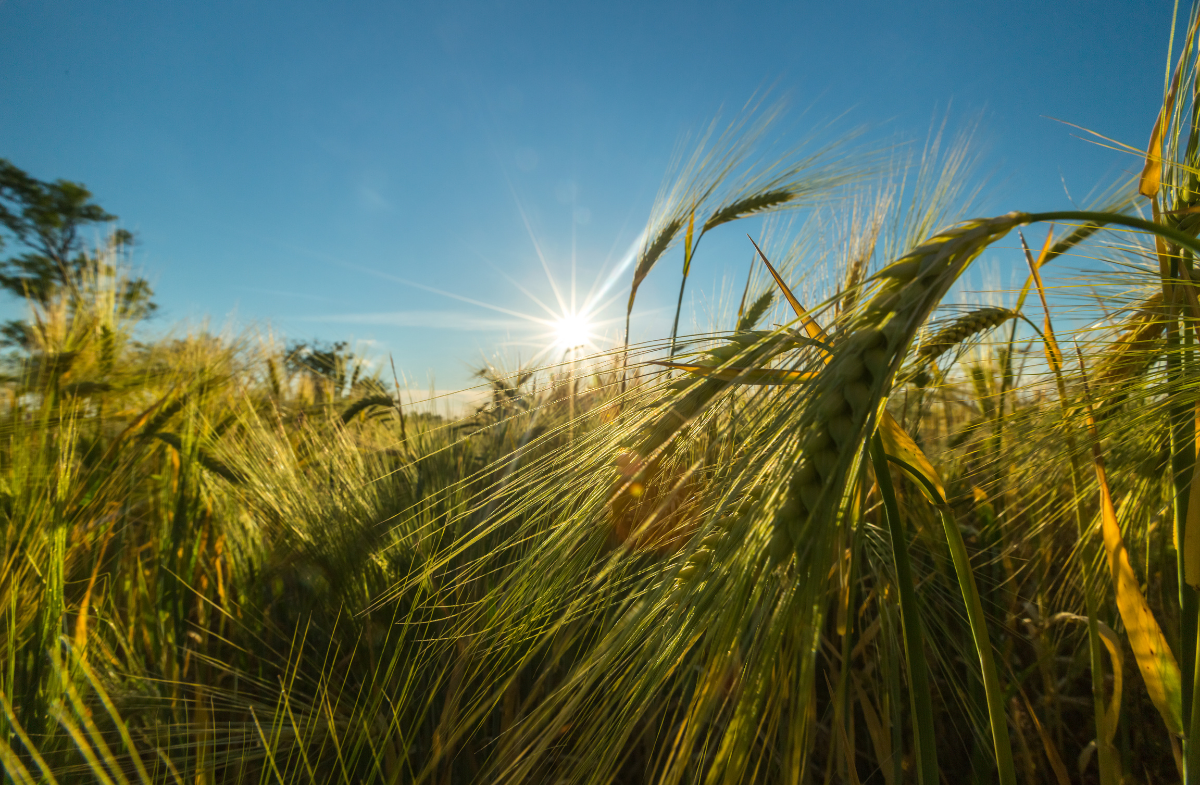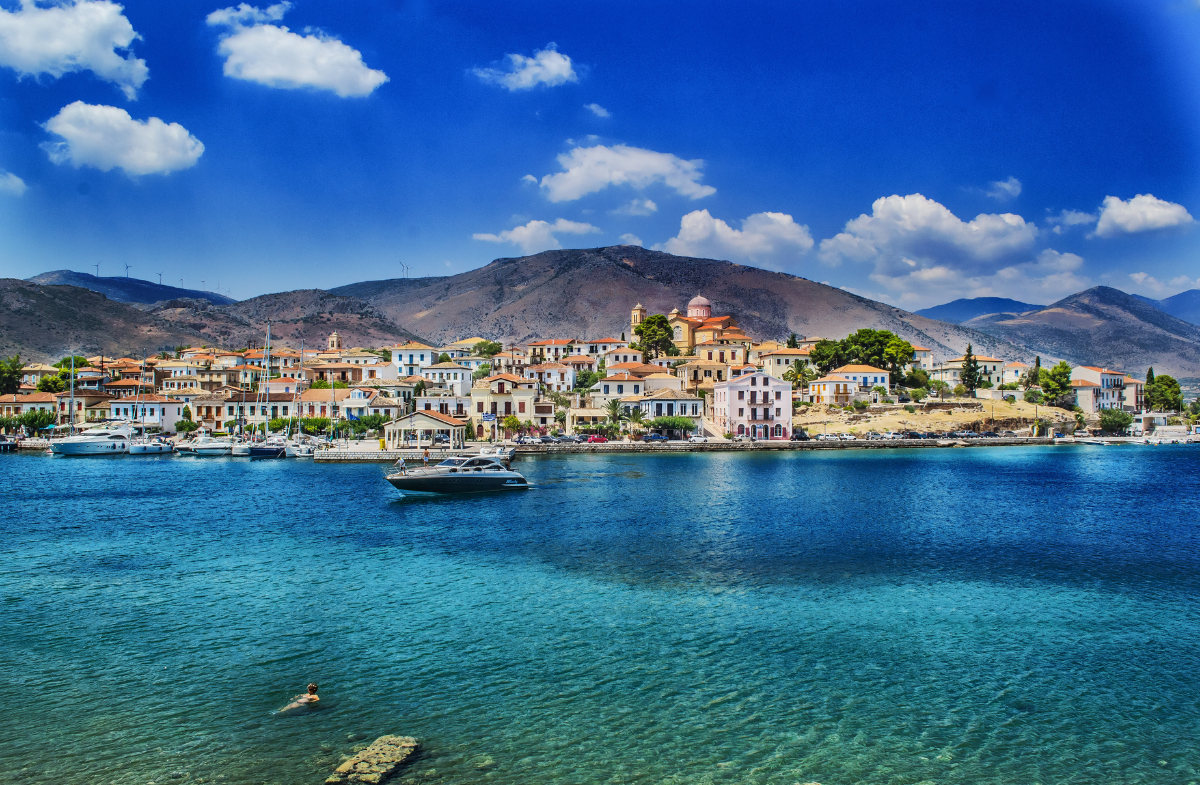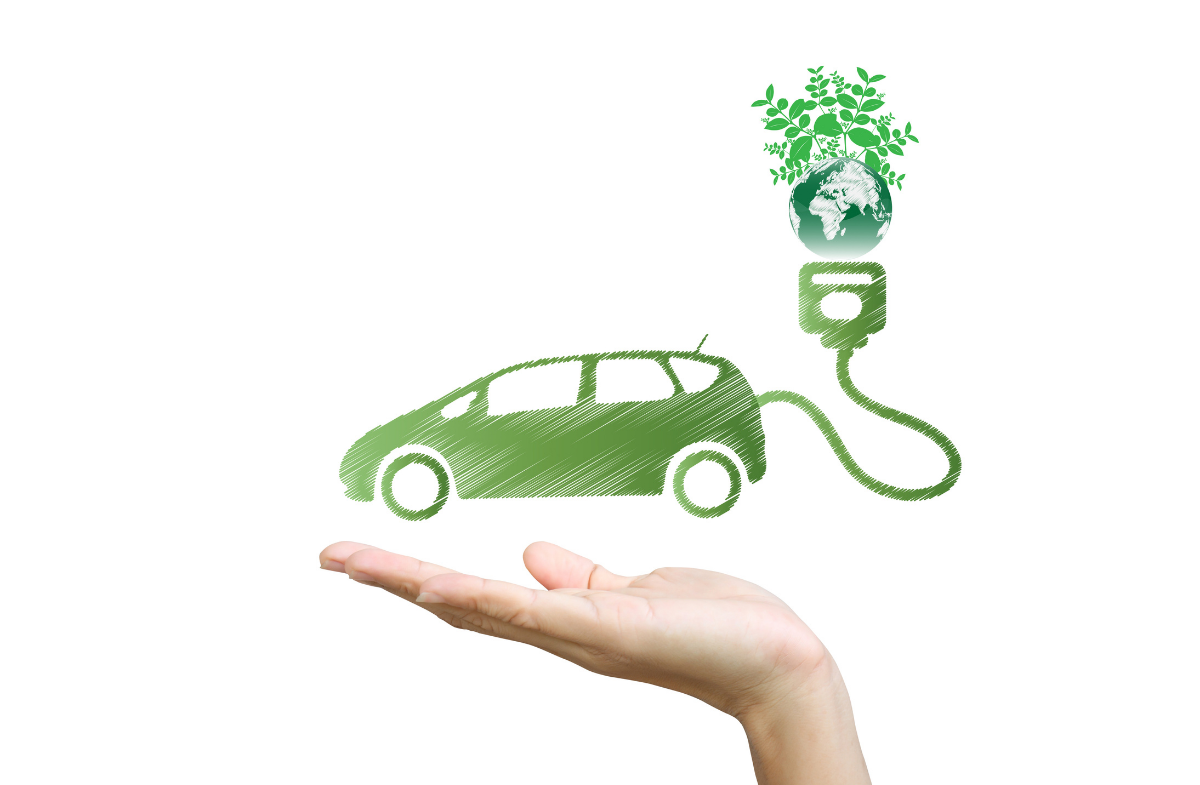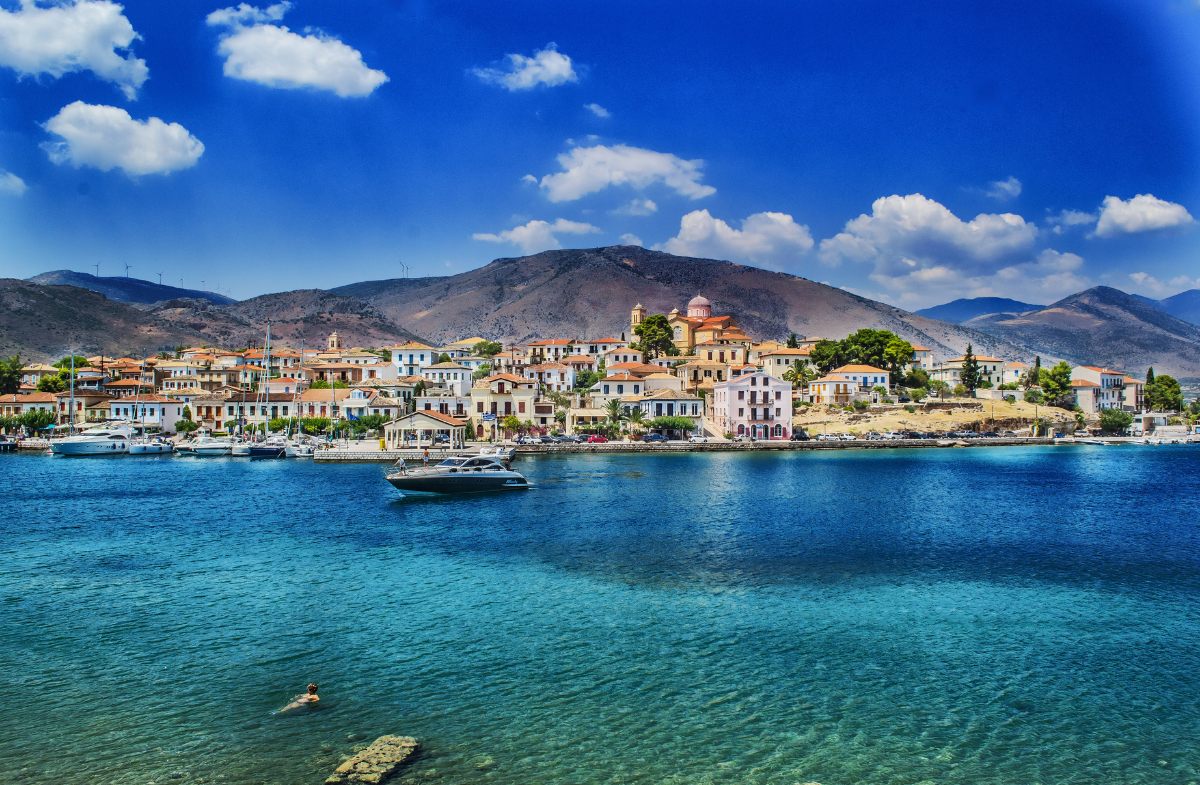W Grecji sektor rolnictwa wytwarza niecałe 4% PKB i zatrudnia ok. 15% ludzi czynnych zawodowo. W rolnictwie Grecji przeważają drobne, rodzinne gospodarstwa rolne (65% ma 1-5 ha). Główne uprawy to: bawełna, oliwki i ryż, pistacje, migdały, winorośl, tytoń czy kukurydza. W ostatnim czasie na popularności zyskuje rolnictwo ekologiczne, co jest spowodowane zwiększającym się zainteresowaniem wśród społeczeństwa produktami ekologicznymi. Czego dowiesz się z artykułu: Rolnictwo ekologiczne – czym jest? Rozwój rolnictwa ekologicznego w Grecji Ekologiczna uprawa winorośli w Grecji Czym jest organizacja WWOOF Rolnictwo ekologiczne – czym jest? Jest to ogólny system prowadzenia gospodarstwa i produkcji żywności charakteryzujący się kilkoma podstawowymi cechami, które są zarówno korzystne dla człowieka jak i środowiska. Do tych cech należy przede wszystkim zastosowanie praktyki rolniczej (w tym sadowniczej i hodowlanej) najbardziej przyjaznej środowisku przy jednoczesnym utrzymywaniu wysokiej różnorodności biologicznej i zachowaniu naturalnych procesów. Ponadto dbanie o ochronę zasobów naturalnych oraz wysokie standardy bazujące na naturalnych składnikach produkcji i hodowli zwierząt. Zatem rolnictwo ekologiczne jest alternatywą do rolnictwa konwencjonalnego zarówno pod względem etycznym jak i dbania o zdrowie i środowisko naturalne. Rozwój rolnictwa ekologicznego w Grecji Oficjalna praktyka rolnictwa ekologicznego w Grecji pojawiła się po raz pierwszy w latach 80., wraz z wdrożeniem rozporządzenia UE 2092/91; pierwsze certyfikaty ekologiczne rozpoczęły się kilka lat później, w 1993 roku. Grecja zmierza w kierunku bardziej konkurencyjnego rolnictwa zorientowanego na rynek, dążąc do wytwarzania produktów wysokiej jakości i markowych. Wykorzystując przewagi różnych obszarów i regionów (między innymi żyzność gleb czy ukształtowanie terenu), rolnictwo przyczynia się do rozwoju greckiej wsi. Promowane jest bardziej ekologiczne i zrównoważone rolnictwo, zwiększając komplementarność między polityką dotyczącą obszarów wiejskich a Odnawialnymi Źródłami Energii (OZE). Nowa era produktów spożywczych o wysokiej wartości odżywczej na greckich lądach i morzach jest na dobrej drodze, co podkreśla znaczenie diety śródziemnomorskiej i greckiej. Ekologiczna uprawa winorośli w Grecji Uprawa winorośli w Grecji korzysta z wielu warunków niezbędnych dla rolnictwa ekologicznego: klimatu umiarkowanego, niezwykłej rzeźby krajobrazu i niewielkich rozmiarów winnic. Jako świadectwo rozpowszechnienia praktyk rolnictwa ekologicznego stosowanych w Grecji, około 50% wszystkich greckich winnic poleca obecnie wina z ekologicznych winogron. Ruch ekologicznej uprawy winorośli stał się tak rozległy, że od 2005 roku odbywa się coroczny konkurs na wina z ekologicznych winogron. Czym jest organizacja WWOOF Organizacja WWOOF (Worldwide Opportunities on Organic Farms) ma na celu pomoc swoim gospodarzom (WWOOF host farms), a jednocześnie pozwala odwiedzającym (visitors) dowiedzieć się, co to znaczy uprawiać własną żywność w sposób zrównoważony. WWOOF umożliwia ludziom poznanie żywności ekologicznej, rolnictwa i zrównoważonych sposobów życia. W ten sposób łączy ludzi, którzy podzielają podobne wartości i filozofie. WWOOF Greece jest częścią Federacji Organizacji WWOOF, światowej społeczności, która promuje świadomość ekologicznych praktyk rolniczych i zrównoważonego stylu życia. WWOOF powstał w 1971 roku w Wielkiej Brytanii i jest jednym z pierwszych na świecie programów wymiany edukacyjnej i kulturalnej. Dziś WWOOF jest obecny w ponad 132 krajach na całym świecie (i rozwija się).WWOOF Greece łączy się ze 145 ekologicznymi farmami goszczącymi w Grecji.
Parki Narodowe w Grecji
Co powinniśmy o nich wiedzieć? Grecja jest jednym z najbogatszych krajów pod względem bioróżnorodności i różnorodności ekosystemów. Obszary chronione i parki narodowe mogą stanowić kluczową siłę napędową zrównoważonego rozwoju i rewitalizacji gospodarczej tych obszarów. Powierzchnia Grecji jest prawie 2,5 razy mniejsza od terytorium Polski mimo to posiada bardzo bogate i zróżnicowane środowisko naturalne. Jest szczególnie obdarzona rzadką geomorfologią, uderzającymi kontrastami, posiada bowiem zarówno piękne i zróżnicowane wybrzeża jak i wiele skalnych tworów takich jak: jaskinie, przepaści. Pasma górskie stanowią aż 81% ukształtowania terenu Grecji. Kraj ten ma wiele regionów o wielkiej wartości ekologicznej. To spowodowało, iż w Grecji stworzono aż 12 parków narodowych (w Polsce stworzono 23 parki narodowe czyli niecałe dwa razy więcej). Są to: Park Narodowy Parnasu Park Narodowy Parnitha Park Narodowy Samaria Park Narodowy Vikos-Aoös Park Narodowy Ainos Park Narodowy Sunio Park Narodowy Oeta Park Narodowy Prespy Park Narodowy Zakintos Park Narodowy Alonissos Park Narodowy Gór Pindos Narodowy Park Olimpu Przedstawiamy tutaj 5 najważniejszych z nich. PARK NARODOWY GÓRY OLIMP Park Narodowy Góry Olimp to najstarszy park narodowy Grecji. Powstał w 1938 roku. W jego obszarze objęto ochroną cała biosferę. Jest wpisany na listę UNESCO. Jest ona górą należącą do starożytnych bogów. Najwyższy szczyt – Mitikas ( gr. Mytikas 2918 m n.p.m.) to inaczej tron Zeusa. Należy ona do 12 bogów Olimpijskich. Według mitologii na ucztach u Zeusa gościło wielu starożytnych bogów i muz, bogiń – patronek nauki i sztuki. Ich miejscem był Płaskowyż Muz. Wierzono, że próba zdobycia góry bogów zawsze kończy się śmiercią. Do dziś Grecy patrzą na Olimp z szacunkiem. Niedaleko rozciąga się wybrzeże Morza Egejskiego, Paralia, Riwiera Olimpijska, Leptokaria. NARODOWY PARK MORSKI ZAKYNTHOS Narodowy Park Morski Zakynthos został założony w 1999 roku i obejmuje obszar 52 mil kwadratowych, w tym „Zatokę Laganas”, mokradła „Jeziora Keri” i dwie małe wysepki Strofadii. Położony w południowej części wyspy Zakynthos, trzeciej co do wielkości wyspy na Morzu Jońskim, Narodowy Park Morski Zakynthos słynie z obszarów lęgowych żółwi morskich (Caretta) w „Morzu Śródziemnym”. Jest sanktuarium dla fok mnichów. Tutaj goście mogą pływać lub nurkować. Można odkrywać wody lub podążać śladami, pamiętając o tym, aby nie pogorszyć charakterystycznych przestrzeni życiowych żółwi. PARK NARODOWY OETA „Park Narodowy Oeta” został założony w 1966 r. I obejmuje „Górę Oeta” w centralnym regionie Grecji. „Oeta National Park” zajmuje powierzchnię 7 000 hektarów i jest trzecim największym parkiem narodowym w kraju. W ramach sieci Natura 2000 park, w którym ściganie i inne niebezpieczne działania są zabronione, jest domem dla nie mniej niż 50 endemicznych gatunków roślin i kilku nieokiełznanych gatunków życia i ptaków, w tym sarny, królików i dodatkowo niedźwiedzi brunatnych, wilków i żbików. Miłośnicy podróży odwiedzający ten park mogą doświadczyć fantastycznej możliwości obserwacji ptaków, zwiedzić jaskinie i spojrzeć na historyczne centrum klasztoru Agathonos. PARK NARODOWY VIKOS-AOÖS Położony w północno-zachodniej Grecji, w pięknej okolicy Epiru, „Park Narodowy Vikos – Aoös” znajduje się 30 km od Janiny (Ioaninny). Jest to obszar ponad 12 600 hektarów wąwozów i kanionów, jaskiń, jezior i strumieni oraz gęstych lasów. Zbudowany w 1973 r. Park jest domem dla wilków, ciemnych niedźwiedzi i jeleni oraz jest najbardziej lubiany wśród miejscowych ludzi do ćwiczeń na świeżym powietrzu. Ponadto jest uważany za geopark UNESCO ze względu na szeroki asortyment naturalnych przestrzeni życiowych w jego granicach. Działania ekoturystyczne są tutaj dobrze znane. PARK NARODOWY ALONISSOS Dzięki powierzchni 2200 km2, najbardziej rozległemu parkowi morskiemu w Europie i basenie Morza Śródziemnego, Alonissos National Marine Park ma w rzeczywistości wiele gatunków roślin wodnych i fauny morskiej. To prawdziwy raj dla miłośników przyrody i miłośników nurkowania. Znajduje się na północ od wyspy i jest utworzony przez wyspę Alonissos i cztery wysepki: Pelagos, Joura, Psatura i Piperi. W parku morskim Alonissos istnieje ogromna różnorodność lądowych i morskich ekosystemów śródziemnomorskich z setkami gatunków roślin i zwierząt, a także ważnymi zabytkami historycznymi i archeologicznymi. W niektórych obszarach można pływać, nurkować z rurką i podziwiać przyrodę w najdzikszej i nieskazitelnej formie. Morski park narodowy Alonissos korzysta również z wielu zasobów archeologicznych, takich jak artefakty z czasów prehistorycznych, klasycznych i bizantyjskich (wraki statków, starożytne kościoły i klasztory). Goście mogą zwiedzić starożytne zabytki, wybrać się na wędrówkę lub po prostu zrelaksować się na świeżym powietrzu.
Exploitation of marine resources in Greece
Greece is a traditional maritime nation as shipping is probably the oldest form of Greek occupation and has been a key part of economic activity since antiquity. Greece has been at the top of the ship access ranking for centuries. This proves its eternal connection with the sea. In this article you will learn: what are marine resources principles of their acquisition what is their use What are marine resources? Marine resources are all organisms living in the seas and natural resources that can be used by humans. The marine resources include fish and seafood that can be caught. This field is fishing. Hand in hand with catching fish is their breeding, called aquaculture, the variety of which takes place in the sea is mariculture. It is breeding in special structures for fish and other gifts of the sea. Popular fish are mackerel and sardines, as well as shrimp. The farmed species are sea bream, sea bass, rainbow trout and clams. This country is a world producer of mussels that are grown in the northern parts of the Aegean Sea. Unfortunately, due to climate change (increased air temperature), their number has been decimated in recent years compared to previous years. In addition to living organisms, natural resources in the form of crude oil and natural gas are also exploited in Greece. Unfortunately, due to various political complications, these deposits cannot be fully exploited and only meet 5% of the demand. What are the rules for the exploitation of marine resources? The riches of the seas should be exploited in a sustainable manner so as not to disturb the populations of different species, and wisely in the case of natural resources. Greek law governs the advancement of resource extraction. This law covers conservation, resource management, limiting environmental impacts from fishing, oil and gas extraction, fishing fleet efficiency, aquaculture control, organization of sales markets and international relations. What is the impact of the European Union? In addition to the national law in Hellas, the law of the European Union is also in force, resulting from the presence of this country in the ranks of this organization. It lays down the necessary measures to reduce the fishing mortality rate and the environmental impact of fishing. In the event of a serious threat to the ecosystem or for the protection of these resources, the European Commission and other Member States can intervene. Thanks to the above rules and legal regulations, ecosystems are not too strained, and the Greek economy can benefit from them. What is the use of marine resources? The gifts of the sea that are obtained in Greek waters are primarily used in gastronomy as an ingredient of local dishes. These riches are also used in other industries, such as the food, pharmaceutical and cosmetic industries, and natural resources – in the energy sector. Greece was the leading producer with over 120,000 tonnes before the crisis began in 2008. Even since this event, the country is a significant world producer with an annual production of 110,000 tonnes of fish. As much as 2% of the main exports of this country are fresh or frozen fish. In 2015. as much as 78% of Mediterranean marine fish produced in Greece was exported to 32 countries and the rest was used within the country.
Είναι τα ηλεκτρικά αυτοκίνητα οικολογικά;
Τα τελευταία χρόνια, οι άνθρωποι επιλέγουν όλο και περισσότερο να αγοράζουν ηλεκτρικά αυτοκίνητα. Αυτό οφείλεται στο γεγονός ότι πιστώνεται ότι είναι φιλικά προς το περιβάλλον. Είναι όμως πραγματικά καλύτερα για το περιβάλλον;What will you learn from the article: Πλεονεκτήματα και μειονεκτήματα των ηλεκτρικών αυτοκινήτων Σύγκριση ηλεκτρικών και αυτοκινήτων εσωτερικής καύσης Ηλεκτρικό αυτοκίνητο συνδεδεμένο σε σταθμό φόρτισης Πλεονεκτήματα και μειονεκτήματα των ηλεκτρικών αυτοκινήτων Το μεγαλύτερο πλεονέκτημα των ηλεκτρικών οχημάτων φαίνεται να είναι η μείωση των αερίων του θερμοκηπίου που εκπέμπονται κατά την καύση καυσίμων σε κινητήρες εσωτερικής καύσης. Επιπλέον, τα ηλεκτρικά οχήματα επιτυγχάνουν υψηλότερη απόδοση του συστήματος μετάδοσης κίνησης σε σύγκριση με έναν κινητήρα εσωτερικής καύσης (ο τύπος καυσίμου δεν έχει σημασία εδώ). Ένα άλλο πλεονέκτημα είναι ότι οι ηλεκτροκινητήρες είναι σχετικά απλοί στην κατασκευή επειδή έχουν μικρό αριθμό κινούμενων μερών. Ως αποτέλεσμα, καταστρέφονται λιγότερο συχνά, και ως εκ τούτου απαιτούν λιγότερα χρήματα από τον ιδιοκτήτη για την άρση των βλαβών. Ωστόσο, η χρήση βαρέων μετάλλων στην παραγωγή μπαταριών, το λεγόμενο ενεργειακό μείγμα για την επαναφόρτιση μπαταριών και την απόρριψη φθαρμένων μπαταριών είναι βασικές πτυχές του κύκλου ζωής ενός ηλεκτρικού οχήματος που θα πρέπει να ληφθούν προσεκτικά υπόψη ως μέρος μιας προσέγγισης του κύκλου ζωής. εντοπίζουν πιθανές πηγές αυξημένων περιβαλλοντικών επιπτώσεων. Έχει υπολογιστεί ότι κατά την παραγωγή ενός αυτοκινήτου με κινητήρα εσωτερικής καύσης εκπέμπονται στην ατμόσφαιρα 8 τόνοι διοξειδίου του άνθρακα και η παραγωγή ενός ηλεκτρικού αυτοκινήτου ή plug-in υβριδικού (λόγω μπαταριών) φτάνει τους 12 τόνους CO2. Η απόδοση της μπαταρίας μειώνεται με κάθε φόρτιση και η αντικατάσταση της μπαταρίας με μια νέα προσθέτει επιπλέον 4 τόνους διοξειδίου του άνθρακα. Εκπομπή διοξειδίου του άνθρακα από αυτοκίνητο εσωτερικής καύσης Σύγκριση ηλεκτρικών και αυτοκινήτων εσωτερικής καύσης Νέα έρευνα από τα πανεπιστήμια του Exeter, του Nijmegen – στην Ολλανδία – και του Cambridge δείχνει ότι το 95% του κόσμου, η οδήγηση ενός ηλεκτρικού αυτοκινήτου είναι καλύτερη για το κλίμα από ένα αυτοκίνητο που κινείται με βενζίνη – αναφέρει το BBC. Εξαίρεση σε αυτό αποτελεί για παράδειγμα η Πολωνία, όπου η ηλεκτρική ενέργεια παράγεται κυρίως με άνθρακα. Σύμφωνα με αυτές τις μελέτες, η μέση εκπομπή ρύπων καθ’ όλη τη διάρκεια ζωής των ηλεκτρικών οχημάτων είναι 70% μικρότερη από τα βενζινοκίνητα αυτοκίνητα σε χώρες όπως η Σουηδία και η Γαλλία (όπου το μεγαλύτερο μέρος της ηλεκτρικής ενέργειας προέρχεται από ανανεώσιμες πηγές ενέργειας και πυρηνική ενέργεια) και περίπου 30 % λιγότερο στο Ηνωμένο Βασίλειο. Επιπλέον, τα συμπεράσματα αυτών των μελετών επισημαίνουν ότι το 2050 κάθε δεύτερο αυτοκίνητο στους δρόμους του κόσμου μπορεί να είναι ηλεκτρικό. Αυτό θα μείωνε τις παγκόσμιες εκπομπές CO2 έως και 1,5 γιγατόνους ετησίως, που ισοδυναμεί με τις συνολικές τρέχουσες εκπομπές CO2 της Ρωσίας, αναφέρει το BBC. Volvo XC40 Οι ειδικοί συνέκριναν τις εκπομπές CO2 για τα τελευταία Polestar 2 και Volvo XC40 με βενζινοκινητήρα. Στο στάδιο της παραγωγής, το τελευταίο είναι το κορυφαίο. Η κατασκευή του Polestar 2 ισοδυναμεί με την εκπομπή 24 τόνων διοξειδίου του άνθρακα και στην περίπτωση του XC40 – «μόνο» 14 τόνων. Αυτή η κατάσταση προκαλείται κυρίως από την ανάγκη απόκτησης μετάλλων σπάνιων γαιών που χρησιμοποιούνται στη μπαταρία έλξης. Για να ταιριάζει με το αποτύπωμα άνθρακα του ηλεκτρικού crossover Polestar και Volvo, κάθε αυτοκίνητο χρειάζεται να διανύσει 31.000 μίλια (περίπου 50.000 km), υποθέτοντας ότι οι μέσες εκπομπές CO2 για το XC40 είναι 163 g/km. Εξέτασαν επίσης την ποσότητα των συνδυασμένων εκπομπών διοξειδίου του άνθρακα και των δύο μοντέλων μετά από 125.000 μίλια (περίπου 201.000 km). Υποθέτοντας ότι το Polestar 2 τροφοδοτείτο από ανανεώσιμες πηγές ενέργειας σε αυτήν την απόσταση, η λειτουργία του θα είχε ως αποτέλεσμα την εκπομπή μόλις 0,4 τόνων CO2. Με αυτή την υπόθεση, το βενζινοκίνητο XC40 είναι σίγουρα δυσμενές – η οδήγηση αυτού του αυτοκινήτου θα μεταφραζόταν σε εκπομπές έως και 41 τόνων CO2, που είναι πάνω από 100 φορές περισσότερο σε σύγκριση με το Polestar.
Are electric cars ecological?
In recent years, people are increasingly choosing to buy electric cars. This is due to the fact that they are credited with being eco-friendly. But are they really better for the environment? What will you learn from the article: Pros and cons of electric cars Comparison of electric and internal combustion cars Pros and cons of electric cars The greatest advantage of electric vehicles seems to be the reduction of greenhouse gases emitted during the combustion of fuels in internal combustion engines. In addition, electric vehicles achieve higher efficiency of the drive system compared to an internal combustion engine (the type of fuel is irrelevant here). Another advantage is that electric motors are relatively simple to build because they have a small number of moving parts. As a result, they break down less frequently, and therefore require less money from the owner to remove breakdowns. However, the use of heavy metals in the production of batteries, the so-called energy mix for recharging batteries and disposal of worn out batteries are key aspects of an electric vehicle’s life cycle that should be carefully considered as part of a life cycle approach to identify possible sources of increased environmental impact. It has been calculated that during the production of a car with an internal combustion engine 8 tons of carbon dioxide are emitted into the atmosphere and the production of an electric car or plug-in hybrid (due to batteries) is as much as 12 tons of CO2. The efficiency of the battery decreases with each charge, and replacing the battery with a new one adds an additional 4 tons of carbon dioxide. Comparison of electric and internal combustion cars New research from the universities of Exeter, Nijmegen – in the Netherlands – and Cambridge shows that 95 percent of world, driving an electric car is better for the climate than a car powered by gasoline – reports the BBC. An exception to this is for example Poland, where electricity is generated mainly using coal. According to these studies, the average emission over the entire lifetime of electric vehicles is 70% less than gasoline-powered cars in countries such as Sweden and France (where most of the electricity comes from renewable energy sources and nuclear energy), and around 30% less in the UK. What’s more, the conclusions of these studies point out that in 2050 every second car on the streets of the world may be electric. This would reduce global CO2 emissions by up to 1.5 gigatonnes per year, which is equivalent to Russia’s total current CO2 emissions, the BBC reports. Experts compared CO2 emissions for the latest Polestar 2 and Volvo XC40 with a gasoline engine. At the production stage, the latter is the top. The construction of the Polestar 2 is equivalent to the emission of 24 tons of carbon dioxide, and in the case of the XC40 – “only” 14 tons. This state of affairs is primarily caused by the need to obtain rare earth metals used in the traction battery. To match the carbon footprint of the electric Polestar and Volvo crossover, each car needs to cover 31,000 miles (approx. 50,000 km), assuming an average CO2 emissions for the XC40 of 163 g / km. They also examined the amount of the combined carbon dioxide emissions of both models after 125,000 miles (approx. 201,000 km). Assuming that the Polestar 2 was powered by renewable energy over this distance, its operation would have resulted in the emission of just 0.4 tonnes of CO2. With this assumption, the gasoline XC40 is definitely unfavorable – driving this car would translate into the emission of as much as 41 tons of CO2, which is over 100 times more compared to the Polestar.
Środowisko przyrodnicze Grecji
Parki narodowe na terenie Hellady Na terenie całej Grecji znajduje się 12 parków narodowych, są to: Park Narodowy Parnasu, Park Narodowy Parnitha, Park Narodowy Samaria, Park Narodowy Vikos-Aoos, Park Narodowy Ainos, Park Narodowy Sounio, Park Narodowy Oeta, Park Narodowy Prespy, Park Narodowy Zakintos, Park Narodowy Alonissos. Park Narodowy Olimp, Park Narodowy Gór Pindos. W tym dwa ostatnie parki znajdują się na terenach górskich. Park Narodowy Olimpu Najwyższy masyw górski w Grecji – Olimp – siedziba bogów Najwyższym szczytem w Grecji jest Mitikas, położony na masywie górskim Olimpu. Mierzy on 2918 m.n.p.m. Sąsiaduje on z trzema innymi wierzchołkami Olimpu: Skolio (2912 m), Stefani (2909 m) i Skala (2866 m). Pierwszego udokumentowanego wejścia na szczyt dokonali Daniel Baud-Bovy i Frederic Boissonnas oraz prowadzący ich Christos Kakalos w 1913 roku.
National Parks in Greece #2
What should we know about them? Greece is one of the richest countries in biodiversity and ecosystem diversity. Protected Areas and National Parks may constitute a key driver of sustainable development and economic revitalization of these areas. The area of Greece is almost 2.5 times smaller than the territory of Poland, yet it has a very rich and varied natural environment. It is especially blessed with a rare geomorphology, striking contrasts, as it has both beautiful and varied coasts and many rock formations such as caves and chasms. Mountain ranges account for as much as 81% of Greece’s landscape. The country has many regions of great ecological value. As a result, as many as 12 national parks were created in Greece (Poland has 23 national parks, which is twice as many). These are: Parnassus National Park Parnitha National Park Samaria National Park Vikos-Aoös National Park Ainos National Park Sounio National Park Oeta National Park Prespy National Park Zakynthos National Park Alonissos National Park Pindos Mountains National Park and last but not least Olimp National Park We present here the 5 most important of them. OLYMPUS NATIONAL PARK Mount Olympus National Park is the oldest national park in Greece. It was established in 1938. In his bios we go into full protection. It is included in the UNESCO list. Sent limp is the mountain of the ancient gods. The highest peak – Mitikas (Mytikas 2,918 m above sea level) on the throne of Zeus. Here, the feasts of the gods are used and ambrosia is used to establish immortality. According to mythology, many ancient gods and muses, goddesses – patrons of science and art, were hosted at the feasts at Zeus. Their place was the Plateau of the Muses. It was believed that an attempt to reach the mountain of the gods always ends in death. To this day, the Greeks look at Mount Olympus with respect. Near the first coast of the Aegean Sea, Paralia, Ria Olimpijska, Leptokarya. ZAKYNTHOS NATIONAL PARK Zakynthos National Marine Park was established in 1999 and covers an area of 52 square miles, including “Laganas Bay”, “Keri Lake” wetlands and two small islands of Strofadia. Situated in the south of Zakynthos, the third largest island in the Ionian Sea, Zakynthos National Marine Park is famous for its breeding ground for sea turtles (Caretta) in the “Mediterranean Sea”. There is a sanctuary for monk seals. Here, guests can swim or snorkel. You can explore the waters or follow the footsteps, being mindful not to worsen the turtle’s characteristic living spaces. OETA NATIONAL PARK The “Oeta National Park” was established in 1966 and includes “Mount Oeta” in the central region of Greece. “Oeta National Park” covers an area of 7,000 hectares and is the third largest national park in the country. As part of the Natura 2000 network, the park, where prosecution and other dangerous activities are prohibited, is home to no fewer than 50 endemic plant species and several untamed species of life and birds, including roe deer, wild hog, rabbit and additionally brown bears, wolves and wildcats. Travel enthusiasts visiting this park can experience fantastic bird watching opportunities, explore the caves and gaze at the historic center of Agathonos Monastery. VIKOS- AOÖS NATIONAL PARK Located in the northwest of Greece in the beautiful countryside of Epirus, the “Vikos – Aoös National Park” is 30 km from Ioannina. It is an area of over 12,600 hectares of ravines and canyons, caves, lakes and streams, and dense forests. Built in 1973, the park is home to wolves, dark bears and deer and is the most popular among the local people for outdoor exercise. In addition, it is considered a UNESCO geopark due to the wide assortment of natural living spaces within its borders. Ecotourism activities are well known here. ALONISSOS NATIONAL PARK It is not shocking that Greece also has a marine park. The Alonissos Marine Park was improved in 1992 and is one of the provider of secured sea territories in Europe. In addition to protecting the sea, the park also includes six small and 22 islands. This natural park in Greece is the perfect living space for several species of systems, including these 300 species, 80 bird species, Gioura wild goat, red coral, Audouin’s gull and Eleanor’s hawk. Visitors can explore the park by snorkeling or swimming and, if they are lucky, they may even see some seals. sightseeing, additional items and fishing (only for additional materials) for other basic activities here.
National Parks in Greece
What should we know about them? Greece is one of the richest countries in biodiversity and ecosystem diversity. Protected Areas and National Parks may constitute a key driver of sustainable development and economic revitalization of these areas. The area of Greece is almost 2.5 times smaller than the territory of Poland, yet it has a very rich and varied natural environment. It is especially blessed with a rare geomorphology, striking contrasts, as it has both beautiful and varied coasts and many rock formations such as caves and chasms. Mountain ranges account for as much as 81% of Greece’s landscape. The country has many regions of great ecological value. As a result, as many as 12 national parks were created in Greece (Poland has 23 national parks, which is twice as many). These are: Parnassus National Park Parnitha National Park Samaria National Park Vikos-Aoös National Park Ainos National Park Sounio National Park Oeta National Park Prespy National Park Zakynthos National Park Alonissos National Park Pindos Mountains National Park and last but not least Olimp National Park We present here the 5 most important of them. OLYMPUS NATIONAL PARK Mount Olympus National Park is the oldest national park in Greece. It was established in 1938. In his bios we go into full protection. It is included in the UNESCO list. Sent limp is the mountain of the ancient gods. The highest peak – Mitikas (Mytikas 2,918 m above sea level) on the throne of Zeus. Here, the feasts of the gods are used and ambrosia is used to establish immortality. According to mythology, many ancient gods and muses, goddesses – patrons of science and art, were hosted at the feasts at Zeus. Their place was the Plateau of the Muses. It was believed that an attempt to reach the mountain of the gods always ends in death. To this day, the Greeks look at Mount Olympus with respect. Near the first coast of the Aegean Sea, Paralia, Ria Olimpijska, Leptokarya. ZAKYNTHOS NATIONAL PARK Zakynthos National Marine Park was established in 1999 and covers an area of 52 square miles, including “Laganas Bay”, “Keri Lake” wetlands and two small islands of Strofadia. Situated in the south of Zakynthos, the third largest island in the Ionian Sea, Zakynthos National Marine Park is famous for its breeding ground for sea turtles (Caretta) in the “Mediterranean Sea”. There is a sanctuary for monk seals. Here, guests can swim or snorkel. You can explore the waters or follow the footsteps, being mindful not to worsen the turtle’s characteristic living spaces. OETA NATIONAL PARK The “Oeta National Park” was established in 1966 and includes “Mount Oeta” in the central region of Greece. “Oeta National Park” covers an area of 7,000 hectares and is the third largest national park in the country. As part of the Natura 2000 network, the park, where prosecution and other dangerous activities are prohibited, is home to no fewer than 50 endemic plant species and several untamed species of life and birds, including roe deer, wild hog, rabbit and additionally brown bears, wolves and wildcats. Travel enthusiasts visiting this park can experience fantastic bird watching opportunities, explore the caves and gaze at the historic center of Agathonos Monastery. VIKOS- AOÖS NATIONAL PARK Located in the northwest of Greece in the beautiful countryside of Epirus, the “Vikos – Aoös National Park” is 30 km from Ioannina. It is an area of over 12,600 hectares of ravines and canyons, caves, lakes and streams, and dense forests. Built in 1973, the park is home to wolves, dark bears and deer and is the most popular among the local people for outdoor exercise. In addition, it is considered a UNESCO geopark due to the wide assortment of natural living spaces within its borders. Ecotourism activities are well known here. ALONISSOS NATIONAL PARK It is not shocking that Greece also has a marine park. The Alonissos Marine Park was improved in 1992 and is one of the provider of secured sea territories in Europe. In addition to protecting the sea, the park also includes six small and 22 islands. This natural park in Greece is the perfect living space for several species of systems, including these 300 species, 80 bird species, Gioura wild goat, red coral, Audouin’s gull and Eleanor’s hawk. Visitors can explore the park by snorkeling or swimming and, if they are lucky, they may even see some seals. sightseeing, additional items and fishing (only for additional materials) for other basic activities here.
Smog – Poland vs Greece
Smog is a dense fog mixed with smoke or car exhaust fumes. It most often appears in large cities and industrial areas. It is created by pollutants such as dust and gases. The valleys are mostly exposed to smog. Which pollutants are the most harmful? Dioxins, furans and polycyclic hydrocarbons are the most toxic, they adsorbed PM2.5 dust particles. An additional threat is the high concentrations of sulfur dioxide and nitrogen dioxide (they also increase under the conditions of temperature inversion). Causes of smog in Poland Industry – The main cause of smog in Poland is industry, it is responsible for the emission of 21.1% of PM2.5 dust. The main problem are petrochemical plants, metal smelters, as well as the garment industry. Transport – Road transport produces as much as 10% of PM2.5 in the atmosphere. Motor vehicles produce a lot of sulfur and nitrogen oxides, which have a negative impact on human health. The concentration of traffic pollution is highest in large cities near busy streets. Agriculture – 2.1% of PM2.5 dust ends up in the atmosphere as a result of farm operations. The reason is using nitrogen fertilizers, which leads to the formation of ammonium ions that spread over long distances. They combine with pollutants from other sources, leading to the formation of particulate matter. Causes of smog in Greece Agriculture – Greece is famous for a wide variety of vegetables, fruits and plants, the production of which begins with cultivation. They grow on natural or artificial fertilizers, which contribute to the emission of ammonia. Tourism – Due to besutiful values, this country has developed tourism, which is also associated with problems. Cars, planes, buses, motorcycles, ski lifts, snow groomers, snow cannons emit harmful compounds. They contribute to acid rainfall that destroys nature. They also cause noise that disturbs animals and may change their behavior. Forest fires – Fires are also a big problem for the coastal country. A significant amount of carbon dioxide is released into the atmosphere, which begins to spread with the wind. The direct effect of fires is also total or partial damage to plants that are responsible for the production of oxygen. How to protect yourself from smog? Nowadays, the awareness of how smog affects health is clearly higher today than it was a few years ago. Still, many people do not realize that long-term exposure to inhalation of dust exposes us to serious diseases from the respiratory, cardiovascular and nervous systems. First of all, avoid being outside when the dust concentration exceeds the level considered relatively safe (in order to be up to date in Poland, you can install a mobile application or follow the website GIOŚ)Wearing anti-smog masks during periods of high pollution concentration. How to prevent smog? The most effective method of counteracting smog is the introduction with regulations that would ban using the old, substandard furnaces and the burning of poor-quality coal products,Limit car driving,Do not burn waste such as plastic, tires, clothes,Connecting single-family houses to the municipal network will eliminate the problem of burning in old stoves.
Saving electricity
Clever electricity management is not only ecological, but also economical. Energy bills can really surprise and become a huge burden on the household budget. Among the many methods, it is worth choosing those that will be easiest to introduce in life everyday. Learn more about how do it. Using daylight! The best way to save money is to use daylight. It is worth organizing space in your home to best light the rooms. If you work at home at a computer, place your desk next to the window. In that you will guarantee greater access of light to the workplace. Turning off the lights! Many of us forget about a simple habit that helps saving energy. Unfortunately, we easily ignore the fact of turning off the light in rooms where there are no household members. It is worth paying attention to this habit, which will help us save electricity. Energy-saving bulbs! The third way to save electricity is to replace the bulbs with those that consume less electricity. Although energy-saving bulbs are slightly more expensive than decent ones, they consume less electricity. Replace such bulbs start from the places where you light most often. Disabling unused equipment from switch! Did you know that unused equipment very often continues to draw electricity? Therefore, turning off equipment that we do not use is very important. Try not to use standby mode. Although it’s very convenient, the console or laptop will start in a few seconds, the financial benefits of completely turning off the device will compensate you for temporary discomfort. In short: A good way to save energy is to invest in appropriate lighting. In that the proper use of devices, we can save electricity at home. Saving electricity also helps to protect the environment. What bill subsidies are available? Households can apply for subsidies to recompensate for increases. In 2022, it is especially an “energy supplement”. The surcharge can range from 20 PLN up to 1437.50 PLN. Ways to save without changing your habits: An interesting way to save money is to choose the proper electricity tariff. We distinguish two tariffs: night – it could be helpful when you heat the house with electricity or have an electric car; weekend – it is useful in the event that we consume more energy on Saturdays and Sundays. When we save electricity, it does not need to be produced in larger and larger quantities, in that we pollute our environment less. For lower electricity consumption, we pay smaller bills, i.e. we save both our money and electricity.











